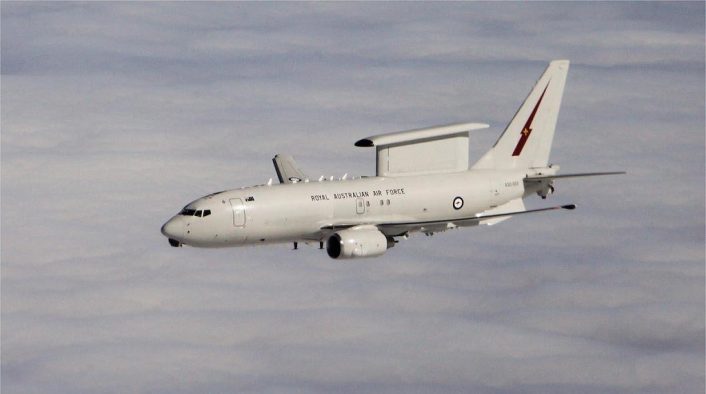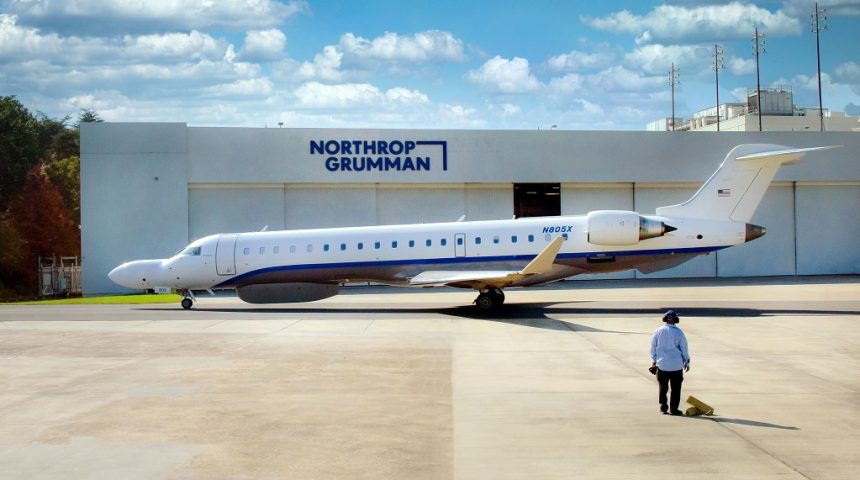Boeing And Northrop Grumman tested new Open Mission Systems-compliant Airborne Early Warning & Control System on CRJ-700 testbed aircraft. The new technology concept will allow quicker and cheaper upgrades of the aircraft’s capabilities
Boeing is working on upgrades for its E-7A Airborne Early Warning & Control (AEW&C) platform, based on the midsize jet-powered Boeing 737-700 commercial aircraft, by integrating Open Mission Systems-compliant components. In collaboration with Northrop Grumman, Boeing recently conducted two flight tests on a testbed CRJ-700 aircraft (owned by NG) integrating the company’s Battle Management Command and Control (BMC2) system with an unspecified advanced wide-band Active Electronically Scanned Array (AESA) radar developed by NG. Both the systems are said to be OMS-compliant.
Northrop Grumman is the developer of the Multi-role Electronically Scanned Array (MESA) radar located on a dorsal fin on top of the E-7’s fuselage, which provides 360-degree surveillance capability (although it doesn’t rotate like the E-3 Sentry’s antenna) with both air-to-air and air-to-surface coverage with and integrated Identification Friend or Foe system. Even if the MESA uses AESA technology, the radar located in the fairing under the CRJ-700’s fuselage appears to be much smaller than the MESA’s antenna, so this could either be a scaled down version or an entirely new sensor in development for a future integration on the E-7.
During the flight tests conducted in an operational environment, Boeing’s operators used the Human-Machine Interface (HMI) of the BMC2 system to command the AESA radar to focus on specific targets, capture and manage data, and communicate the information back to the mission computing system, which was displayed in real-time on the operator’s workstation, successfully transferring relevant active-passive kill chain data.
Success! Two flight tests validated our Airborne Early Warning & Control system paired with a @NorthropGrumman sensor can communicate with one another in an open mission system environment. This allows our customers to add or upgrade capabilities. pic.twitter.com/iqllvzyl85
— Boeing Defense (@BoeingDefense) November 9, 2020
The Open Mission Systems in an initiative of the U.S. Air Force Research Laboratory’s Virtual Distributed Laboratory aimed “to develop industry consensus for a non-proprietary mission system architectural standard that enables affordable technical refresh and insertion, simplified mission systems integration, service reuse and interoperability, and competition across the life-cycle”, focusing on the interfaces between software services and hardware subsystems, and how data is exchanged across them.
The evolution of the battlespaces introduced more complex and dynamic threats, often shifting also to unconventional solutions, requiring a quicker evolution for military aircraft and their capabilities to counter them. Compared to legacy systems, the OMS architecture allows to add new or improved capabilities on operational aircraft very quickly and at a reduced cost, which is also very convenient in an era of continuous defense budget restraints. This is possible due to the common interfaces and data formats that are shared by all systems and producers, as defined by the AFRL, cutting the time needed to develop custom interfaces between components from different producers.
Open Mission Systems and Open Communication Systems will be also important to address driving mission needs and ensure multi-domain interoperability in future scenarios, allowing a highly-effective Joint All-Domain Command and Control (JADC2) that connects distributed sensors, shooters and data from all domains to all forces.

Both Northrop Grumman and Boeing are pleased by the results of the joint live flight test which was said to have demonstrated a key step in continuing the validation and integration of OMS-compliant systems.
“From an engineering standpoint, executing this OMS test in a relevant environment, represents a major step up in demonstrated readiness,” said Rick Greenwell, Boeing chief engineer for Aircraft Modernization and Modification. “[…] It is a major accomplishment to take the OMS architecture from lab and ground testing to the air, and connecting it to an operating sensor in an environment similar to flying an operational mission. Open architecture is a very efficient way of doing software engineering and bringing capabilities across platforms.”
“These demonstrations continue to act as pathfinders to enable further OMS opportunities,” said Paul Kalafos, vice president for Surveillance and Electromagnetic Maneuver Warfare at Northrop Grumman. “Using an agile framework, we can quickly develop and adapt complex, multi-function systems to enable multi-mission nodes at the tactical edge of the battlespace, be it Joint All-Domain Command and Control (JADC2), electronic warfare, or intelligence, surveillance and reconnaissance.”
Before the flight tests, the two systems were integrated and tested on the ground last month. In the ground test scenario, similarly to what was later replicated inflight, the AESA radar was commanded by the BMC2 system to focus on specific areas of interest for potential “threats”, with both systems responding as expected and locating and transmitting the radar contacts back to the mission computing system, which were subsequently displayed on the operator’s workstation.
The Boeing E-7A AEW&C aircraft and its Northrop Grumman MESA radar has already been in service for some years with the Royal Australian Air Force, the Republic of Korea Air Force and the Turkish Air Force. According to Boeing, these operators demonstrated interest in OMS upgrades for their fleets and laid out some requirements for future programs.
The latest customer for the E-7 is the Royal Air Force, with five aircraft on order that will be delivered from 2023 to 2026 to replace the E-3D Sentry AEW Mk1, but it is not known if they will receive OMS systems yet or if they will be upgraded later. Interestingly, two of the aircraft are said to be second-hand overhauled aircraft that will be converted to the E-7 configuration. The RAF decided to adopt the same Wedgetail designation like the RAAF, specifically E-7 Wedgetail AEW Mk1. NATO has also demonstrated interest in the E-7 for a possible replacement of its E-3s.









